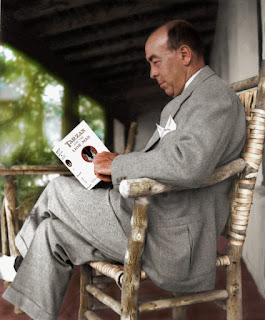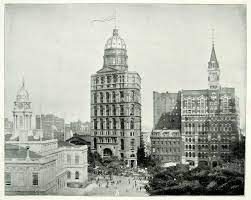When putting the Tarzan book series into a calendar timeline a researcher soon runs into many challenges. One is that the author does not provide all the information that it takes to complete the chronology. If not, where does one discover that hidden data? One method is through history.
This 1872 Greystoke family timeline, known as the pushback theory, is based on the fact that Tarzan was a human being living on the planet Earth that we live on. Therefore, if Edgar Rice Burroughs mentions a historical fact it would be fair to insert that historical data into a Greystoke chronology. Let me provide one of many quick examples.
Chapter twelve of The Return Of Tarzan describes Jane and William Cecil's relationship which covers quite a period. The next thing we learn about the ape-man is that he is twenty-two years old, has taken the name Jean C. Tarzan, and is on board a French ship bound for France three days out of New York. This was when the jungle lord met the forty-year-old, Count Raoul de Coude, and his twenty-year-old wife, Countess Olga de Coude.
Tarzan was on an oceanliner three days out of New York on his way back to Paris, France. The very attractive Countess de Coude makes the statement to her husband. "Oh, nothing at all my dear. I was but recalling with admiration those stupendous skyscrapers, as they call them, in New York." ERB-The Return Of Tarzan. This passage can actually be used to form an unprovided date or to confirm one. The key word here is "skyscrapers'. What is the proper definition of the word skyscraper, and when did the actual name come about?
The word skyscraper actually has two definitions. The original definition was a tall, continuously habitable building having multiple floors. There is no universally accepted definition other than being very tall high-rise buildings. Historically, the term first referred to buildings with between ten and twenty stories when these types of buildings began to be constructed in the 1880s. At that time the structures were simply called tall buildings. These first-generation skyscrapers were later dubbed by historians as "proto-skyscrapers"
The first pro-to-skyscraper in New York City was the Tribune Building which was completed in 1875. At eleven stories, the Tribune was the first tall building on Newspaper Row across from City Hall. The structure is of gigantic height and immense solidity and was built of brick laid in cement, with dressings of stone and granite, The steeple on the clock tower was two hundred sixty feet above the sidewalk, surmounting a building containing a sub-seller, basement, nine stores, and attic. The walls of the lower portion, sustaining the great weight of the masonry, are five feet, two inches to six feet thick. The building was claimed to be absolutely fireproof. No wood was used in its construction, except floorings, doors, and windows. The building featured two electric elevators powered by steam and illuminated by gaslight.
A second type of pro-to-skyscraper was built in New York City in 1848 by James Bogardus; It was made with a rigid frame of cast iron providing the main support for upper floors and roof loads. This structure was stronger and safer than the masonry skyscrapers but it was still designed to be 10 to 20 stories high.
As years passed technology, materials, tools, equipment, safety, and experience progressed immensely. The modern definition of skyscrapers evolved into forty to fifty-story buildings being three hundred thirty feet or four hundred ninty feet and having a steel frame. The oldest steel-made skyscraper in New York City is the twenty-one-story Flatiron Building on Twenty-third Street where Broadway crosses Fifth Avenue. Completed in 1902, it was built in the shape of a triangle. Although this is the first modern-era skyscraper in New York it was not the first in the U.S.
That privilege goes to the Home Insurance Building in Chicago, IL. which was constructed by William Le Baron Jenney in 1884-1885. With its completion, the ten-story hundred thirty-eight-foot-tall steel girder building became the first structure dubbed a "skyscraper".
The next step in the process is to apply this information to both the 1888 and 1872 chronologies and see if they agree with ERB's provided descriptions.
1888 Tarzan was born.
1908 Tarzan Of The Apes ends. The Jungle Lord is twenty years old.
1908 The Return Of Tarzan begins when the ape-man is twenty-two years old. Countess Olga de Coude describes the tall buildings of New York City as "skyscrapers".
1910 Tarzan and Jane marry. The Return Of Tarzan ends. Countess Olga de Coude
The word "skyscrapers" came into use in 1885 so this timeline agrees with ERB's provided information. Now let's examine the 1872 version.
1872 Tarzan was born.
1892 Tarzan Of The Apes ends. The Jungle Lord is twenty years old.
1892 The Return Of Tarzan begins when the ape-man is twenty-two years old. Countess Olga de Coude describes the tall buildings of New York City as "skyscrapers".
1894 Tarzan and Jane marry. The Return Of Tarzan ends.
As shown above, the word "skyscrapers" came into use in 1885. Since Olga's "skyscrapers" description occurred in 1892, the 1872 timeline also agrees with ERB's provided information.
.ABOUT THE AUTHOR
James Michael Moody is a lifelong fan and collector of Edger Rice Burroughs. Over the past forty-five years, Moody has contributed over two hundred articles to various ERB-related fanzines. He also manages an unauthorized Tarzan blog titled Greystoke Chronologist: James Michael Moody. There, the researcher chronologies the Tarzan books starting in May 1872 (known as the pushback theory) instead of the more accepted date, May 1888.
James Michael Moody also authorizes the action-packed Sci-Fi fantasy adventure Unium series. Pioneers On Unium, published December 31, 2019, Exiled On Unium, published August 25, 2022, and, Swordsman On Unium published on July 15, 2024.










No comments:
Post a Comment